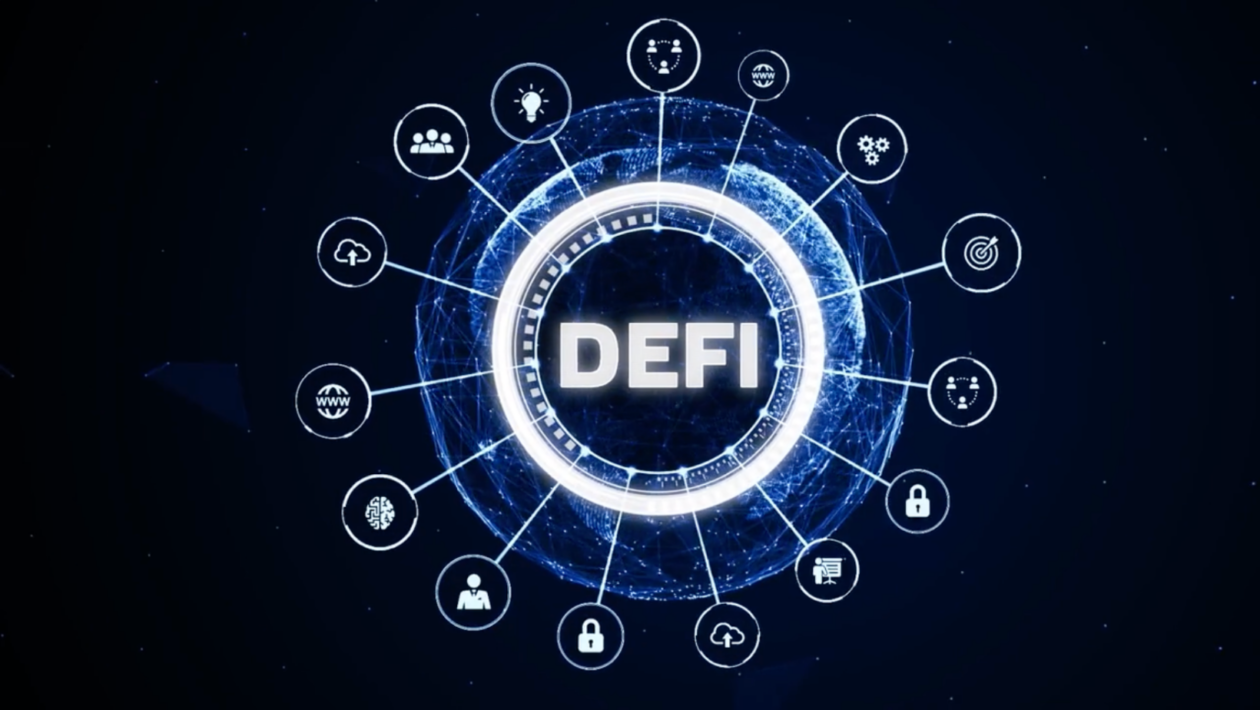Imagine a world where you can transfer money, earn interest, take out loans, and trade assets, all without needing a bank or traditional financial institution. That’s the promise of Decentralized Finance (DeFi). It’s a groundbreaking shift powered by blockchain technology, fundamentally altering how we think about money, transactions, and control over our finances.
If you’ve ever wondered what DeFi is, how it works, and why it’s considered the future of finance, you’re in the right place. Let’s break it all down in a conversational and easy to follow way.
What Is DeFi?
At its core, Decentralized Finance (DeFi) are financial services that are based on blockchain technology that operate without intermediaries like banks or brokerages. Instead, these services rely on smart contracts—self-executing agreements with the terms written directly into code.
With DeFi, users can:
- Borrow and lend assets without needing approval from a bank.
- Trade cryptocurrencies without the need for relying on a centralized exchange.
- Earn passive income through staking or liquidity provision.
- Access financial services globally, regardless of location or credit score.
Essentially, DeFi aims to create a more open, transparent, and accessible financial system.
The Key Technologies Behind DeFi
DeFi’s capabilities stem from blockchain development and crypto development. These technologies provide the foundation for creating decentralized systems that are secure, transparent, and resistant to censorship.
-
Blockchain Development
Blockchain is the backbone of DeFi. It uses a distributed ledger that records all transactions in an immutable and transparent way. Key characteristics of blockchain include:
- Decentralization: A network of nodes validate the transactions rather than a central authority.
- Transparency: Each transaction is publicly visible on the blockchain.
- Security: Cryptographic algorithms protect data from tampering.
The most popular blockchain for DeFi applications is Ethereum, known for its robust smart contract capabilities. Other blockchains like Solana, Binance Smart Chain, and Polkadot are also gaining traction in the DeFi space.
-
Crypto Development
The creation and management of cryptocurrencies play a significant role in DeFi. Cryptocurrencies like Ether (ETH) and stablecoins like DAI or USDC are used as the primary assets for transactions, lending, and liquidity pools within DeFi platforms.
Crypto development enables the creation of unique tokens that power DeFi ecosystems, each serving specific purposes like governance, rewards, or collateralization.
How Does DeFi Work?
DeFi platforms use smart contracts, another helpful feature of blockchain technology to automate and execute financial services. Here’s how the system works step by step:
-
Smart Contracts
Think of smart contracts as digital vending machines. You put something in (like cryptocurrency), and based on predefined rules, the machine executes the desired action without needing a third party.
For example:
- Lending platforms use smart contracts to match borrowers and lenders automatically.
- Decentralized exchanges (DEXs) facilitate peer to peer trading without needing any centralized authority.
-
Decentralized Applications (DApps)
DeFi services are accessed through decentralized applications, or DApps. These apps run on blockchain networks and offer a user-friendly interface for interacting with DeFi protocols.
Popular DeFi DApps include:
- Uniswap (for decentralized trading)
- Aave (for lending and borrowing)
- Yearn.Finance (for yield farming)
-
Liquidity Pools and Staking
DeFi platforms often rely on liquidity pools, where users contribute their assets to enable smooth trading or lending operations. In return, contributors earn rewards, such as interest or additional tokens.
For example:
- A user might stake ETH in a liquidity pool on Uniswap and earn fees from trades involving that pool.
Why Is DeFi Important?
DeFi is transforming traditional finance by offering several advantages:
-
Financial Inclusion
With DeFi, anyone using the internet can access financial services. There are no credit checks or minimum account balances required.
-
Transparency
Every transaction on a blockchain is recorded publicly, fostering internal accountability and reducing the risk of fraud.
-
Reduced Costs
By cutting out intermediaries, DeFi services are often more affordable than traditional financial services.
-
Programmable Money
Smart contracts enable features like automated payments, complex financial derivatives, and tokenized real-world assets.
-
Global Accessibility
DeFi operates 24/7, allowing users to transact or access services anytime, anywhere in the world.
Examples of DeFi in Action
Let’s explore a few real-world applications to understand the impact of Defi:
-
Decentralized Lending and Borrowing
Platforms like Compound and Aave allow users to lend their cryptocurrencies and earn interest. On the flip side, borrowers can access loans by providing crypto assets as collateral.
Fact: As of 2023, the total value locked (TVL) in DeFi lending protocols surpassed $50 billion, showcasing the growing demand for decentralized financial services.
-
Decentralized Exchanges (DEXs)
Unlike traditional exchanges, DEXs like Uniswap and SushiSwap allow users to trade cryptocurrencies directly, eliminating the need for a central authority, promoting greater privacy and control.
-
Stablecoins
Stablecoins, such as DAI and USDC, provide a bridge between volatile cryptocurrencies and fiat currencies. They are widely used in DeFi for lending, borrowing, and trading.
Challenges and Risks in DeFi
While DeFi offers numerous benefits, it’s not without its challenges:
-
Volatility
Cryptocurrencies are inherently volatile, which can pose risks for borrowers and lenders.
-
Smart Contract Vulnerabilities
Bugs or errors in smart contracts can lead to exploits and significant financial losses. In 2022 alone, almost $3 billion was lost due to DeFi hacks.
-
Regulatory Uncertainty
DeFi operates in a gray area when it comes to regulations, which can deter institutional adoption and create legal risks for users.
-
Scalability
As DeFi grows, blockchain networks face scalability issues. These issues can lead to high transaction fees and slower processing times. Emerging blockchains and crypto development efforts aim to address these challenges.
The Role of Blockchain Development in DeFi’s Evolution

Blockchain development plays a pivotal role in addressing the challenges of DeFi. Innovations like Layer-2 solutions (e.g., Polygon) and cross-chain interoperability are enabling faster, cheaper, and more secure transactions.
- Ethereum 2.0, a highly anticipated upgrade, promises to improve transaction speeds and reduce energy consumption.
- The global blockchain market will reach $67 billion by 2026, driven by advancements in DeFi and other sectors.
Additionally, crypto development continues to fuel innovation by creating specialized tokens and platforms tailored to DeFi needs.
The Future of DeFi
DeFi is still in its infancy, but its potential is undeniable. Here’s what the future might hold:
-
Integration with Traditional Finance
DeFi and traditional finance may eventually converge. This will create a hybrid model that combines the best of both worlds. For instance, banks could adopt blockchain-based lending systems to streamline operations.
-
Tokenization of Real World Assets
The tokenization of assets like real estate, art, and stocks could bring new opportunities for investors while increasing liquidity in traditionally illiquid markets.
-
AI and Machine Learning in DeFi
AI-powered analytics could optimize DeFi strategies, such as yield farming and liquidity provision, enhancing profitability for users.
DeFi and the Evolution of Web3
DeFi is more than a standalone innovation; it’s a crucial component of the broader Web3 movement, which envisions a decentralized internet where users have more control over their data and assets.
In this context, DeFi is the financial layer of Web3, enabling decentralized ownership and participation. For example, imagine combining DeFi with the Metaverse, where users could trade virtual real estate or stake tokens to generate income within a virtual world.
This integration showcases how blockchain development is not just revolutionizing finance but also paving the way for a decentralized digital future. As Web3 expands, the interplay between crypto development and DeFi will likely create new opportunities for innovation.
How to Get Started with DeFi
If you’re intrigued by the potential that DeFi holds and want to dive in, here are a few tips:
- 1- Educate Yourself:
Before you jump into the world of DeFi, it’s crucial to familiarize yourself with the foundational concepts that underpin this space. Begin by learning about blockchain technology, which serves as the backbone for decentralized applications. Understanding how crypto development works—especially how cryptocurrencies like Ethereum facilitate transactions—will give you a deeper insight into the DeFi ecosystem. You should also delve into smart contracts, the self executing contracts with the terms of the agreement directly written into code. These are the engine behind many DeFi applications. Consider reading blogs, watching tutorials, and participating in online forums. This will help you stay on top of the latest industry developments and best practices.
-
Choose a Secure Wallet:
To interact with DeFi platforms, you’ll need a crypto wallet, and security is paramount. Platforms like MetaMask, Trust Wallet, and Ledger offer secure solutions for storing your cryptocurrency and interacting with decentralized applications (dApps). Make sure to use two factor authentication (2FA) and backup your private keys or recovery phrases in a safe place. Remember, losing access to your wallet can mean losing access to your funds, so always prioritize security and backup your data.
-
Start Small:
DeFi can be incredibly lucrative, but it can also be risky, especially for beginners. To minimize exposure to loss, it’s a good idea to start with small investments. Begin by experimenting with well-established, reputable DeFi platforms like Uniswap (for decentralized trading) or Aave (for decentralized lending and borrowing). These platforms are user-friendly and have been around for a while, which adds an extra layer of trustworthiness. By starting small, you can get a feel for how transactions work, how to navigate DeFi protocols, and how to manage your assets without putting large sums at risk.
-
Stay Updated:
The DeFi space evolves rapidly, with new platforms, protocols, and governance proposals emerging regularly. Staying informed is essential to avoid pitfalls and seize opportunities. Follow reputable DeFi influencers on social media, read crypto news websites, and subscribe to newsletters or join communities like Reddit’s r/DeFi and Twitter/X to keep your finger on the pulse of the latest developments. Additionally, always review platform audits and community feedback to assess the security and reliability of any new project before participating.
By following these steps, you’ll be well on your way to navigating the world of DeFi with confidence. The key is to remain cautious, stay curious, and continue learning as the ecosystem continues to grow and evolve.
The Power of Decentralization
DeFi is more than just a buzzword—it’s a movement toward a more inclusive and transparent financial system. While it’s not without its challenges, the benefits of decentralization, accessibility, and innovation far outweigh the risks.
Whether you’re a seasoned crypto enthusiast or just starting your journey, understanding the fundamentals of DeFi is crucial in today’s digital age. With advancements in blockchain development and crypto development, the future of finance is being rewritten—and DeFi is leading the charge.
So, are you ready to explore the world of DeFi and take control of your financial future?



